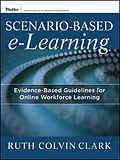Scenario-Based e-Learning
Scenario-Based e-Learning offers a new instructional
design approach that can accelerate expertise, build critical
thinking skills, and promote transfer of learning. This book
focuses on the what, when, and how of scenario-based
e-learning for workforce learning. Throughout the book, Clark
defines and demystifies scenario-based e-learning by offering a
practical design model illustrated with examples from veterinary
science, automotive troubleshooting, sales and loan analysis among
other industries. Filled with helpful guidelines and a wealth of
illustrative screen shots, this book offers you the information
needed to:
* Identify the benefits of a SBeL design for learners and
learning outcomes
* Determine when SBeL might be appropriate for your needs
* Identify specific outcomes of SBeL relevant to common
organizational goals
* Classify specific instructional goals into one or more learning
domains
* Apply a design model to present content in a task-centered
context
* Evaluate outcomes from SBeL lessons
* Identify tacit expert knowledge using cognitive task analysis
techniques
* Make a business case for SBeL in your organization
Praise for Scenario-Based
e-Learning
"Clark has done it again--with her uncanny ability to make
complex ideas accessible to practitioners, the guidelines in this
book provide an important resource for you to build your own
online, problem-centered instructional strategies."
--M. David Merrill, professor emeritus at Utah State
University; author, First Principles of Instruction
"Clark's wonderful book provides a solid explanation of the how,
what, and why of scenario-based e-learning. The tools, techniques,
and resources in this book provide a roadmap for creating engaging,
informative scenarios that lead to tangible, measurable learning
outcomes. If you want to design more engaging e-learning, you need
to read this book."
--Karl M. Kapp, Professor of Instructional
Technology, Bloomsburg University; author, The Gamification of
Learning and Instruction
Autorentext
Dr. Ruth Colvin Clark has worked for over 20 years with training professionals assigned to design, develop, and select effective training for classroom or computer delivery. She is widely published in training and performance improvement periodicals and was recently bestowed a Distinguished Professional Service Award from ISPI. She is the co-author of the best-selling e-Learning and the Science of Instruction.
Zusammenfassung
Scenario-Based e-Learning
Scenario-Based e-Learning offers a new instructional design approach that can accelerate expertise, build critical thinking skills, and promote transfer of learning. This book focuses on the what, when, and how of scenario-based e-learning for workforce learning. Throughout the book, Clark defines and demystifies scenario-based e-learning by offering a practical design model illustrated with examples from veterinary science, automotive troubleshooting, sales and loan analysis among other industries. Filled with helpful guidelines and a wealth of illustrative screen shots, this book offers you the information needed to:
- Identify the benefits of a SBeL design for learners and learning outcomes
- Determine when SBeL might be appropriate for your needs
- Identify specific outcomes of SBeL relevant to common organizational goals
- Classify specific instructional goals into one or more learning domains
- Apply a design model to present content in a task-centered context
- Evaluate outcomes from SBeL lessons
- Identify tacit expert knowledge using cognitive task analysis techniques
- Make a business case for SBeL in your organization
Praise for Scenario-Based e-Learning
"Clark has done it again—with her uncanny ability to make complex ideas accessible to practitioners, the guidelines in this book provide an important resource for you to build your own online, problem-centered instructional strategies."
—M. David Merrill, professor emeritus at Utah State University; author, First Principles of Instruction
"Clark's wonderful book provides a solid explanation of the how, what, and why of scenario-based e-learning. The tools, techniques, and resources in this book provide a roadmap for creating engaging, informative scenarios that lead to tangible, measurable learning outcomes. If you want to design more engaging e-learning, you need to read this book."
—Karl M. Kapp, Professor of Instructional Technology, Bloomsburg University; author, The Gamification of Learning and Instruction
Inhalt
Foreword (Frank Nguyen)
Acknowledgments
Chapter 1: What Is Scenario-Based e-Learning
Scenario-Based e-Learning: A First Look
What Do You think?
Scenario-Based e-Learning Defined
Scenario-Based vs. Directive Training Environments
What Scenario-Based e-Learning Is Not
Six Reasons to Consider Scenario-Based e-Learning Now
What Do You Think? Revisited
Coming Next
Additional Resources
Scenario-Based e-Learning and You: Why Now?
Chapter 2: When to Use Scenario-Based e-Learning
Consider Scenario-Based Learning for Strategic Tasks
What Do You Think?
Situations That Call for Scenario-Based e-Learning
Eight Scenario-Based Learning Domains
Scenario-Based Multimedia Interfaces
Meet the Scenario-Based e-Learning Samples
Coming Next
Additional Resources
Scenario-Based e-Learning and You: Your Scenario-Based e-Learning Opportunities
Chapter 3: Design of Scenario-Based e-Learning
Overview of a Scenario-Based e-Learning Design Model
Modes and Media in Scenario-Based e-Learning
Coming Next
Additional Resources
Scenario-Based e-Learning and You: Your Draft Design Model
Chapter 4: Defining Scenario Outcomes
Outcome Deliverables for Learning Domains
Assess the Complexity of your Outcome Responses
What Do You Think?
Translate Your Learning Objectives
Scenario Outcomes and Multimedia Interfaces
What Do You Think? Revisited
Coming Next
Additional Resources
Scenario-Based e-Learning and You: Translating Your Objectives
Chapter 5: Designing the Trigger Event and Case Data
What Do You Think?
Planning the Trigger Event
Defining Case Data
What Do You Think? Revisited
Coming Next
Scenario-Based e-Learning and You: Defining Your Trigger Event and Case Data
Chapter 6: Building Guidance in Scenario-Based e-Learning
What Do You Think
What Is Guidance?
Option 1: Fade Support from High to Low
Option 2: Move from Simple to Complex
Option 3: Consider Open vs. Closed Response Options
Option 4: Consider Interface/Navigation Design
Option 5: Add Training Wheels
Option 6: Incorporate Coaching and Advisors
Option 7: Embed Worksheets
Option 8: Adjust Feedback
Option 9: Make Learning Collaborative
What Do You Think? Revisited
Coming Next
Additional Resources
Scenario-Based e-Learning and You: Defining Guidance
Chapter 7: Putting the L in Scenario-Based e-Learning
What Do You Think?
Integrating Knowledge and Skill Resources
Tutorials
Reference
Examples
Instructors
What Do You Think? Revisited
Coming Next
Resources
Scenario-Based e-Learning and You: Def…
